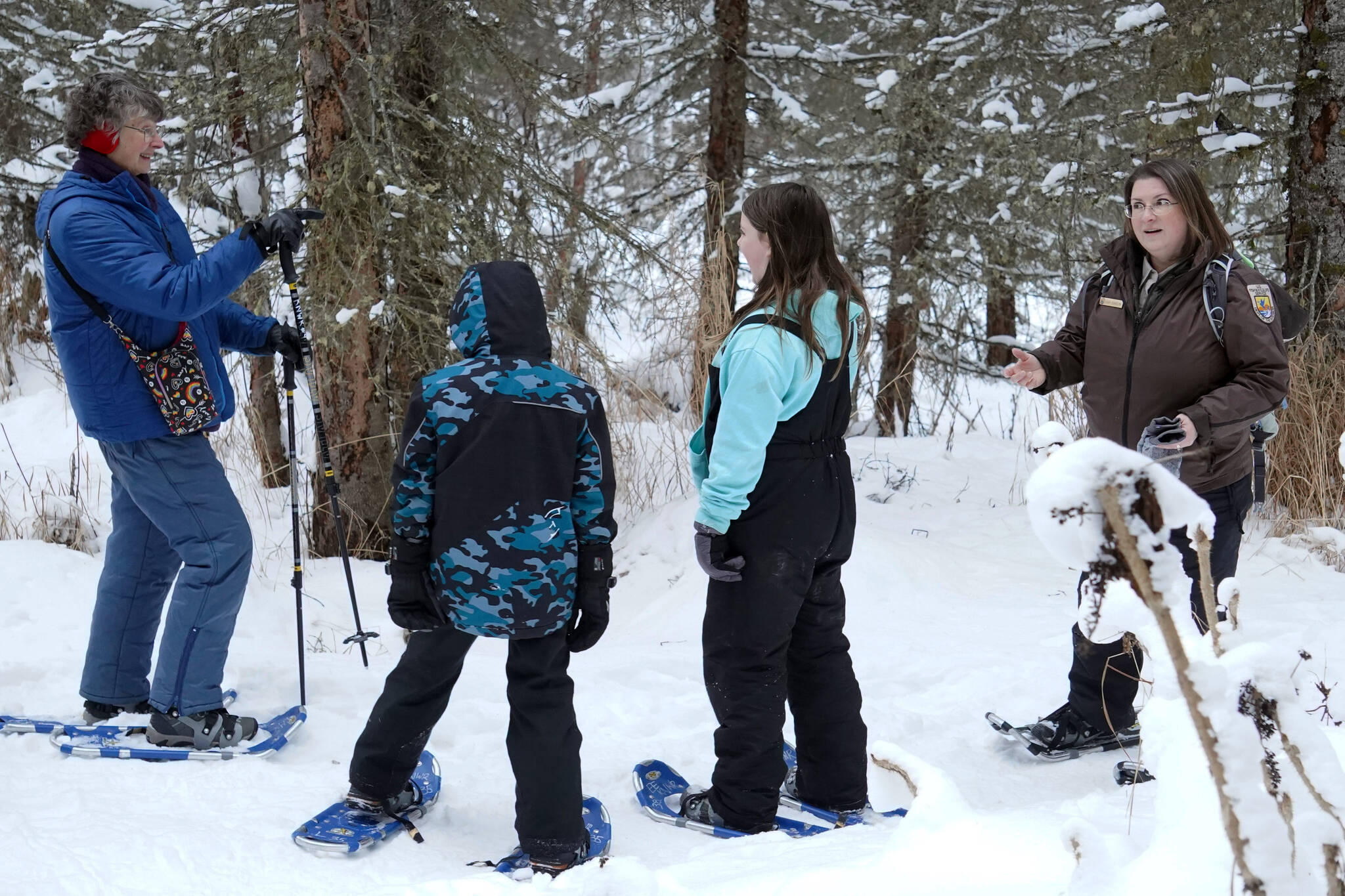Along trails near the Kenai National Wildlife Refuge’s Visitor Center, a procession of around two dozen snowshoers followed Park Ranger Leah Eskelin on a Saturday hike under cloudy skies and the lightest of snowfall.
They were participating in the refuge’s guided snowshoe walks, which offer twice-weekly free opportunities to get out on refuge trails for winter recreation as part of a group led by an experienced guide.
The walks are held each Wednesday at noon and Saturday at 2 p.m. A certain number of snowshoes are available to be borrowed for the sessions for attendees who register in advance.
Eskelin said that snowshoeing is an exciting opportunity for outdoor recreation at the refuge because it doesn’t require a lot of effort or training. It’s an easy way to get outside and explore, to connect with the local community and to take more enjoyment from “long Alaska winters.”
“Snowshoeing is so accessible,” Eskelin said Saturday. “It works for so many different people.”
The group led by Eskelin on Saturday featured snowshoers from a broad age range and experience level. Some attendees were new to the area, others had lived on the Kenai Peninsula for decades. Those more comfortable on the snowshoes offered tips to help others become more efficient and more confident as they proceeded.
“I think that’s cool — to be able to all get together and share an experience outdoors,” Eskelin said.
The session started at the visitor center, where Eskelin provided a quick overview of how snowshoes work, how to put them on and how to avoid a quite-possibly-silly fall.
“You’re going to have two shoes on and strapped up as tight as you think they should be,” she said. “One of us are going to double check — your tight is typically not as tight as they should be.”
Once everyone had their snowshoes on, the group moved down the trails toward Headquarters Lake. Eskelin stopped periodically to point out signs of wildlife or other interesting details like hare tracks or spaces where people had gone off the trail and risked damaging subnivean habitat.
Among the group was Nuno Venturi, an exchange student from Brazil who attended with his host family. He said that the walk was his second experience on snowshoes — that he found the process of traveling with them “weird,” but not difficult.
Spending time in Alaska, he said he’s been seizing every opportunity to get outside in the cold, also going ice fishing, sledding and skiing. He wants to see a glacier.
“If you put on some jackets and snowshoes, you can go outside and enjoy the beauty,” he said.
At the lake, Eskelin told the “wolf pack” to go their separate ways as they explored the lake’s surface. She encouraged people to experiment with the snowshoes by trudging through uncompacted snow, running or using the shoes to make large symbols.
As the group spread, some went vast distances to take pictures, some raced across the ice leaving a large snowy cloud in their wake and more than one took a tumble into the soft snow — an opportunity to learn to stand up with snowshoes on.
When Eskelin’s call brought the group back together, they took a different trail to return from the lake and to the visitor center.
Each session will be a little different, Eskelin said, as different guides will follow different routes. Taking different routes makes for different experiences, but Eskelin says she always feels a pull to include the lake.
“That’s my joy,” she said.
The Wednesday noon sessions are by design a little shorter, to fit into a lunch break window — while on Saturday can be “calmer” with less need to be so time sensitive. The trails are also open to snowshoeing or skiing anytime, not just during guided walks.
“The trails are open 24/7, so with a map it’s not impossible to just try it out on your own,” she said. “It’s way more fun when people come with us to do that first trip.”
In addition to the regularly scheduled snowshoe walks, the refuge will host a special “Full Moon Guided Family Snowshoe Walk” on Jan. 25, running from 4:30 p.m. to 6 p.m. Eskelin said that snowshoeing in the dark under the light of the moon is “a completely different thing” — a “sensory experience.”
The moon illuminates the snow, and more animal sounds can be heard in the relative quiet. It’s also at a slower pace than the regular walks. Because it has “more structure,” all attendees need to register in advance by calling the refuge’s visitor center at 907-260-2820. That’s the same number to call to register for borrowed snowshoes during the standard guided walks.
To keep up with events at the Kenai National Wildlife Refuge, find “Kenai National Wildlife Refuge” on Facebook. Eskelin said people can also call the visitor center to get their names added to an email list that only sends out activity fliers for upcoming programming.
Reach reporter Jake Dye at jacob.dye@peninsulaclarion.com.

